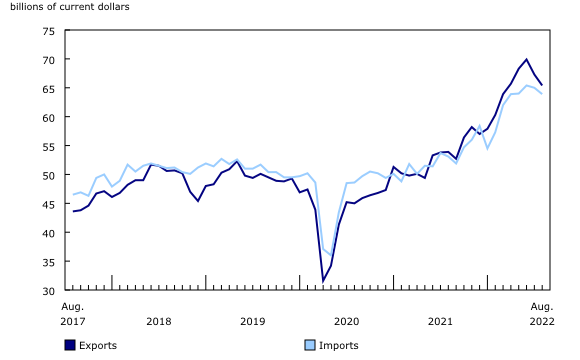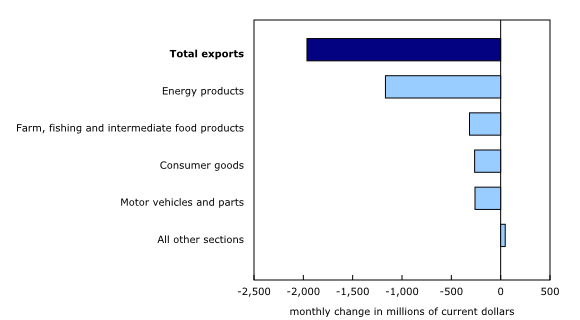Canadian international merchandise trade, August 2022
Archived Content
Information identified as archived is provided for reference, research or recordkeeping purposes. It is not subject to the Government of Canada Web Standards and has not been altered or updated since it was archived. Please "contact us" to request a format other than those available.
Released: 2022-10-05
In August, Canada's merchandise exports decreased 2.9%, largely due to lower exports of energy products. Imports fell 1.7%, mainly on decreased imports of motor vehicles and parts. As a result, Canada's merchandise trade surplus with the world narrowed from $2.4 billion in July to $1.5 billion in August. This is the lowest monthly trade surplus observed to date in 2022.
Consult the "International trade monthly interactive dashboard" to explore the most recent results of Canada's international trade in an interactive format.
Energy products are the driver of the decline in total exports for a second consecutive month
Total exports decreased 2.9% to $65.4 billion in August. Declines were observed in 7 of 11 product sections. A decrease was also seen in July, following six increases in 2022. In real (or volume) terms, total exports fell 1.3% in August, while export prices were down for a third consecutive month.
Exports of energy products fell 6.0% to $18.4 billion in August, a level that represented 28.2% of total exports. This proportion reached an all-time high of 30.1% in June. In August, other than electricity exports, all product subcategories were down. Exports of crude oil (-5.7%) declined the most, largely on lower prices. This drop in prices coincides with increased global production and concerns about the future economic outlook. Exports of refined petroleum products (-10.3%), coal (-10.5%) and natural gas (-4.9%) also contributed to the decline in August. Excluding energy products, total exports were down 1.7%.
After rising 10.2% in July, exports of farm, fishing and intermediate food products decreased 7.1% in August. As in July, wheat exports showed the largest monthly change. Following the poor harvests in the 2021/2022 crop year, wheat production in Canada is expected to increase significantly in the new crop year (2022/2023) that began in August. However, wheat inventories were at a historical low at the end of July, which limited the amount of wheat that could be exported in August. The same can be observed for canola: exports fell 49.0% in August and canola inventories were also at very low levels.
Exports of consumer goods (-3.7%) also contributed to the decline in August. Exports of miscellaneous goods and supplies (-19.2%) fell sharply for a second consecutive month. In both July and August, these exports were down on lower exports of gold bars to the United States. These declines follow peaks observed in May and June.
Imports of motor vehicles and parts post the largest decline
Total imports were down 1.7% to $63.9 billion in August, a second consecutive monthly decline. This is the first time since September 2021 that imports have declined for two consecutive months. Decreases were observed in 8 of the 11 product sections in August, with imports of motor vehicles and parts posting the largest decline. In real (or volume) terms, total imports fell 0.7%.
Following a 12.3% increase in July, imports of motor vehicles and parts fell 7.1% in August. Imports of passenger cars and light trucks (-9.5%) posted the largest decline, followed by imports of engines and parts (-7.4%). Normally, motor vehicle production in North America rebounds in the month of August after slowing down in July due to planned summer shutdowns, which affects imports. However, since the industry continues to be impacted by supply chain issues, the rebound in production was more modest in August this year, contributing to a seasonally adjusted decline in imports of passenger cars and light trucks as well as engines and parts. Passenger cars and light trucks from countries other than the United States, whose imports do not follow the North American production cycle, also contributed to the decrease in August.
Many other product sections contributed to the decline in total imports, posting declines of over $200 million. These included basic and industrial chemical, plastic and rubber product (-4.3%), metal and non-metallic mineral product (-4.1%), electronic and electrical equipment and part (-2.9%), and energy product (-4.3%) imports.
Higher imports of industrial machinery, equipment and parts (+3.6%) partially offset the decrease in total imports. This growth was driven by higher imports from the "other industry-specific manufacturing machinery" product group (+56.1%). Large monthly movements have been observed in this product category since the beginning of 2022, primarily due to imports of machinery and parts for the new liquefied natural gas terminal currently being built in British Columbia. Since high value deliveries for this project do not occur every month, they cause variations in the monthly import levels of this product section.
Trade with the United States declines
Exports to the United States fell 2.5% in August, partly due to lower crude oil exports. At the same time, imports from the United States were down 3.3%, driven in part by lower imports of motor vehicles and parts.
Canada's trade surplus with the United States remained essentially unchanged at $10.7 billion in August.
When the average exchange rates for July and August are compared, the Canadian dollar gained 0.1 US cents relative to the American dollar.
The deficit with countries other than the United States widens for the first time in four months
Exports to countries other than the United States fell 4.3% in August. Exports to Hong Kong (gold), South Korea (coal and crude oil), the United Kingdom (crude oil and gold) and Japan (wheat, canola and copper) posted the largest declines.
Meanwhile, imports from countries other than the United States rose 1.1% in August. Higher imports from China (various products) and Belgium (pharmaceuticals) were partially offset by the decrease in imports from South Korea (light trucks and passenger cars).
The merchandise trade deficit with countries other than the United States widened from $8.3 billion in July to $9.2 billion in August.
Revisions to July merchandise export and import data
Imports in July, originally reported at $64.2 billion in the previous release, were revised to $65.0 billion in the release for the current reference month. Exports in July, originally reported at $68.3 billion in the previous release, were revised to $67.3 billion in the current reference month's release, mainly because estimates for crude oil exports were replaced with actual data.
Monthly trade in services
In August, monthly service exports edged up 0.3% to $12.6 billion. Meanwhile, service imports rose 2.1% to $14.5 billion.
When international trade in goods and international trade in services were combined, exports decreased 2.4% to $78.0 billion in August, while imports were down 1.0% to $78.4 billion. As a result, Canada's trade balance with the world went from a surplus of $740 million in July to a deficit of $369 million in August. This was the first deficit in 2022 for the goods and services combined trade balance.
Note to readers
Merchandise trade is one component of Canada's international balance of payments (BOP), which also includes trade in services, investment income, current transfers, and capital and financial flows.
International trade data by commodity are available on both a BOP and a customs basis. International trade data by country are available on a customs basis for all countries and on a BOP basis for Canada's 27 principal trading partners (PTPs). The list of PTPs is based on their annual share of total merchandise trade—imports and exports—with Canada in 2012. BOP data are derived from customs data by adjusting for factors such as valuation, coverage, timing, and residency. These adjustments are made to conform to the concepts and definitions of the Canadian System of National Accounts.
For a conceptual analysis of BOP-based data versus customs-based data, see "Balance of Payments trade in goods at Statistics Canada: Expanding geographic detail to 27 principal trading partners."
For more information on these and other macroeconomic concepts, see the Methodological Guide: Canadian System of Macroeconomic Accounts (13-607-X) and the User Guide: Canadian System of Macroeconomic Accounts (13-606-G).
The data in this release are on a BOP basis and are seasonally adjusted. Unless otherwise stated, values are expressed in nominal terms, or current dollars. References to prices are based on aggregate Paasche (current-weighted) price indexes (2012=100). Movements within aggregate Paasche prices can be influenced by changes in the share of values traded for specific goods, with sudden shifts in trading patterns—as observed currently with the COVID-19 pandemic—sometimes resulting in large movements in Paasche price indexes. Volumes, or constant dollars, are calculated using the Laspeyres formula (2012=100), unless otherwise stated.
For information on seasonal adjustment, see Seasonally adjusted data – Frequently asked questions.
Revisions
In general, merchandise trade data are revised on an ongoing basis for each month of the current year. Current-year revisions are reflected in both the customs-based and the BOP-based data.
The previous year's customs-based data are revised with the release of data for the January and February reference months, and thereafter on a quarterly basis. The previous two years of customs-based data are revised annually, and revisions are released in February with the December reference month.
The previous year's BOP-based data are revised with the release of data for the January, February, March and April reference months. To remain consistent with the Canadian System of Macroeconomic Accounts, revisions to BOP-based data for previous years are released annually in December with the October reference month.
Factors influencing revisions include the late receipt of import and export documentation, incorrect information on customs forms, the replacement of estimates produced for the energy section with actual figures, changes in merchandise classification based on more current information, and changes to seasonal adjustment factors. The seasonal adjustment parameters are reviewed and updated annually and applied with the October reference month release.
For information on data revisions for exports of energy products, see Methodology for Exports of Energy Products within the International Merchandise Trade Program.
Revised data are available in the appropriate tables.
Real-time data table
The real-time data table 12-10-0120-01 will be updated on October 17.
Next release
Data on Canadian international merchandise trade for September will be released on November 3.
Products
The product "International trade monthly interactive dashboard" (71-607-X) is now available. This new interactive dashboard is a comprehensive analytical tool that presents monthly changes in Canada's international merchandise trade data on a balance-of-payments basis, fully supporting the information presented every month in the Daily release.
The product "The International Trade Explorer" (71-607-X) is now available online.
The Canadian International Merchandise Trade online database is no longer available. It has been replaced by the Canadian International Merchandise Trade Web Application (71-607-X), a modern tool that provides trade data users with a number of enhancements.
The updated "Canada and the World Statistics Hub" (13-609-X) is now available online. This product illustrates the nature and extent of Canada's economic and financial relationship with the world using interactive charts and tables. It provides easy access to information on trade, investment, employment and travel between Canada and a number of countries, including the United States, the United Kingdom, Mexico, China, Japan, Belgium, Italy, the Netherlands and Spain.
Contact information
For more information, or to enquire about the concepts, methods or data quality of this release, contact us (toll-free 1-800-263-1136; 514-283-8300; infostats@statcan.gc.ca) or Media Relations (statcan.mediahotline-ligneinfomedias.statcan@statcan.gc.ca).
- Date modified:








